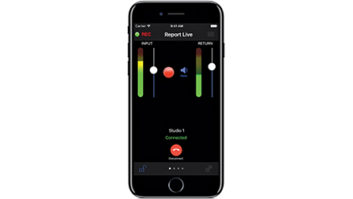It’s now no longer a question of if, but rather when, the wireless Internet will have measurable impact on radio listening. The proliferation of broadband wireless devices (both handhelds and automotive) and 3G/4G services (using EV-DO, HSDPA and WiMAX technologies) is well underway, and popular units like the iPhone already offer branded applications that make it easy to listen to certain Internet radio streams. Some Internet radio services also present iPhone-optimized pages to which iPhone users are automatically directed when seeking those URLs from that platform.
The effect of this trend on broadcast radio can be either positive or negative, depending on which streams users choose to listen to.
If they are broadcasters’ streams, those stations thereby extend their brand and influence to a new platform. This is particularly important because many of those handheld devices do not include broadcast radio receivers, so the path for broadcasters’ content to flow to the users of these devices is via wireless broadband, not AM or FM transmission. If listeners choose non-broadcast Internet radio streams on these devices, however, this is yet another nail in broadcast radio’s coffin.
Thus it is critical for broadcasters to acknowledge this movement and to compete in this fast-moving marketplace. This implies that broadcast engineers should now become familiar with the process and platforms involved, if they are not already.
(click thumbnail)iStockphoto/Betsy Dupuis
Some large broadcasters may want to address these new platforms (such as the iPhone) on their own, while it may make sense for other broadcasters to work with a third party — such as Radiolicious, iheartradio or others — for such efforts.
Alas, poor Radio…
It seems a bit silly to broadcasters to have to go through the Internet to get to these devices when they exist within stations’ local broadcast coverage zones, but such is the control that wireless network operators obtain through their subsidy of these devices.
There is still a battle afoot over whether at least FM receivers will be included (via mandate or voluntarily) in wireless devices, but odds appear to be against this happening to any large measure. It is therefore to broadcasters’ advantage to play along rather than fight; discretion is the better part of valor.
Consider that getting to these handsets costs the broadcasters no more than it does to get to any other unicast Internet terminal, so if the 3G path is the only way in, why not take it?
Another advantage to broadcasters is the continuing improvement of the quality and penetration of Internet audio delivery. The cost of these rapid and massive infrastructure improvements are borne by the network operators, and are essentially free to broadcasters or other streaming providers.
Think of it as a third-party transmitter company that carries your content to a secondary set of users at minimal cost, and which continues to expand the coverage and quality of its delivery service for you at no extra charge. (If anything, bandwidth costs to large users like streaming audio services are decreasing in many cases.)
Of course, most of the cost for this delivery service is actually paid by the end users, who are willing to do so to get Internet access in general. The fact that Internet radio becomes available in the process seems like a bonus feature to these customers, and thus it appears “free” — which fits nicely into the broadcast service tradition.
Broadcasters are not the direct beneficiary of any of this service revenue collected by wireless networks, but they can benefit indirectly via advertising, as they always have. Bandwidth costs to broadcasters can be considered as paid in lieu of transmitter amortization and maintenance. On a per-listener basis, these fees may be at relative parity to the ongoing cost of supporting over-the-air delivery (depending on the relative sizes of on-air vs. online audiences).
Meanwhile, the 3G network providers obtain a great value-add to the appeal of their service from Internet radio offerings, giving them further incentive to not include AM/FM receivers on their devices.
Note also that the general trend of telecom providers toward “triple play,” in which the same service provider offers multichannel TV, telephone and Internet access, or even “quad play,” in which wireless voice/data service is bundled as well, notably leaves out radio — at least the broadcast variety (i.e., some TV services include their own music channels, which are either the remains of the old “cable radio” services, or provided as alternate delivery services by Sirius XM).
All’s well that ends well?
So if radio broadcasters in the U.S. are to take their place among the digital service trinity of Voice, Video and Data, it will necessarily be by their own doing, via the Data component.
This implies that they will also have to promote their presence there, since they will be bundled among a nearly infinite number of other services, and in a “pull” environment, which is quite a different service model than what broadcasters are used to.
That could be the greatest challenge of all, but a synergistic balance of cross-promotion and counter-programming between on-air and online services could provide an extremely powerful combination in the new media world, and is something only broadcasters can offer.
Also bear in mind that while wireless Internet service may seem a far cry from broadcast radio in terms of availability and coverage today, this too is changing rapidly.
Consider that today there are already resourceful listeners who choose to listen to local AM stations via the (wired) Internet, preferring the quality and building penetration of the streaming service over the RF delivery — no surprise, if the Internet is available and free at the listener’s location.
Beyond such early shifts, the eventual goal of wireless service providers is seamless 3G/4G coverage in most markets, with some devices perhaps even switching transparently between transmission technologies. This could truly make radio delivery via Internet streams a viable equivalent (or in some cases, superior, as in the AM example above), even within broadcasters’ local markets.
As an interesting and relevant aside, consider that T-Mobile already offers a phone that switches between the cellular network and VoIP-over-WiFi during a call.
(For example, a user can start a voice call in the car via the cellular network, and upon reaching home, office or anywhere else where a WiFi hotspot open to the device exists, continue the call via WiFi without even knowing the switch had occurred — unless the user happened to look at the handset’s screen, where an icon displays the current connection mode.
Notably, T-Mobile bills for the call from where it started, so although WiFi calls are free, if the call was started on the cellular network, the time spent in WiFi mode still counts against the caller’s cellular minutes. On the other hand, the opposite is also true; a call started in a WiFi hotspot remains free even after it switches onto the cellular network, at least under the current billing scheme.)
Some anecdotal reports have also circulated recently regarding Internet radio listening via 3G in a moving vehicle, which found remarkable continuity over long distances. (Other informal tests have found the opposite, however, so this capability is not yet broadly assured.)
Finally, remember that Internet radio listening is measurable, more so than over-the-air service, in fact, since it can be accomplished either via streaming service reports from host servers, or via audience research (diary or PPM). Any out-of-market listening via the Web is a bonus, but it will be difficult to monetize.
Thus broadcasters’ focus should be on building audience for their streaming services in their local markets, and adding this component to their traditional sales processes.
So it’s once more unto the breach for radio broadcasters. Exploring this area sooner rather than later is the prudent course, since it may soon become an important venue by which your countrymen lend you their ears.













